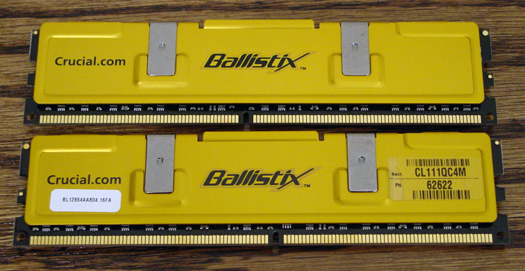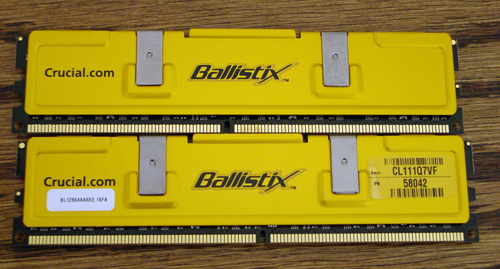Crucial Ballistix DDR2: The New DDR2 Standard?
by Steve Carmel & Wesley Fink on February 21, 2006 12:05 AM EST- Posted in
- Memory
Intel 975X Memory Test Configuration
Test Settings
All hard drives were completely formatted with a fresh OS installation. Four partitions were made, with one for the operating system, a small partition containing the paging file, an applications partition, and finally a storage partition. Using standard benchmark practice, all drives were defragmented after installation of programs and before any tests were run. Diskeeper 10 Professional Premier was the defragmentation program of choice.
Memory Module Information:
Crucial DDR2 PC2-6400
DDR2 testing on an Intel based platform proves to be a different beast entirely. Most enthusiasts know well the effects of brute force front side bus clocks, as the memory frequency produces a bigger effect on performance than does latency. It presents a bit of a conundrum as you can use different multipliers and memory ratios, either at a 1:1 ratio or up-clocked via the chipset memory strap. Ideally, a phase changed or water cooled solution might be best for testing, as one could use a 12X multiplier on the 955 EE, ramp the front side bus speeds up to 400 MHz, effectively running at DDR 800 in this manner. By maintaining this same strap during a review of DDR2 products on an Intel based platform, you would be able to see results more comparable to DDR memory testing on an Athlon 64 platform.
A remaining issue with Intel's 955 Extreme Edition processor is that the P4 Netburst architecture is still bottlenecked by its front side bus. Until Intel comes around to an integrated memory controller-type solution favored currently by AMD, it will be hard for them to be competitive on the memory latency front, as current generations of AMD processors have shown in a gaming or multi-tasked environment.
| Processor: | Intel 955 Extreme Edition at 13X Ratio (3.46 GHZ dual core 65nm CPU) |
| RAM: | Crucial Ballistix DDR2 PC2-5300 (2 x 1024 MB) Crucial Ballistix DDR2 PC2-6400 (2 x 1024 MB) |
| Hard Drives: | Maxtor DiamondMax Plus 9 160 GB ATA/133 - 8 MB Cache Seagate 7200.9 ST3500641AS SATA NCQ - 16 MB Cache |
| Video Card: | EVGA 7800 GTX KO 256MB |
| Video Drivers: | NVIDIA ForceWare Release 80/Version: 81.98 |
| Power Supply: | PC Power and Cooling Turbo-Cool 850-SSI |
| Operating System(s): | Windows XP Professional SP2 Windows XP Professional x64 Edition |
| Motherboard: | ASUS P5WD2-Premium |
| BIOS: | AMI version 0302 January 17, 2006 |
Test Settings
All hard drives were completely formatted with a fresh OS installation. Four partitions were made, with one for the operating system, a small partition containing the paging file, an applications partition, and finally a storage partition. Using standard benchmark practice, all drives were defragmented after installation of programs and before any tests were run. Diskeeper 10 Professional Premier was the defragmentation program of choice.
Memory Module Information:
Crucial DDR2 PC2-6400
- Part Number: BL2KIT12864AA804
- Module Size: 2GB kit (1GBx2)
- Package: Ballistix 240-pin DIMM
- Feature: DDR2 PC2-6400
- Configuration: 128Meg x 64
- DIMM Type: UNBUFFERED
- Error Checking: NON-ECC
- Speed: DDR2-800
- Voltage: 2.2V
- Memory Timings: 4-4-4-12
- Specs: DDR2 PC2-6400 (2.2V)

- Part Number: BL2KIT12864AA663
- Module Size: 2GB kit (1GBx2)
- Package: Ballistix 240-pin DIMM
- Feature: DDR2 PC2-5300
- Configuration: 128Meg x 64
- DIMM Type: UNBUFFERED
- Error Checking: NON-ECC
- Speed: DDR2-667
- Voltage: 2.2V
- Memory Timings: 3-3-3-12
- Specs: DDR2 PC2-5300 (2.2V)

DDR2 testing on an Intel based platform proves to be a different beast entirely. Most enthusiasts know well the effects of brute force front side bus clocks, as the memory frequency produces a bigger effect on performance than does latency. It presents a bit of a conundrum as you can use different multipliers and memory ratios, either at a 1:1 ratio or up-clocked via the chipset memory strap. Ideally, a phase changed or water cooled solution might be best for testing, as one could use a 12X multiplier on the 955 EE, ramp the front side bus speeds up to 400 MHz, effectively running at DDR 800 in this manner. By maintaining this same strap during a review of DDR2 products on an Intel based platform, you would be able to see results more comparable to DDR memory testing on an Athlon 64 platform.
A remaining issue with Intel's 955 Extreme Edition processor is that the P4 Netburst architecture is still bottlenecked by its front side bus. Until Intel comes around to an integrated memory controller-type solution favored currently by AMD, it will be hard for them to be competitive on the memory latency front, as current generations of AMD processors have shown in a gaming or multi-tasked environment.










27 Comments
View All Comments
Griotspeak - Sunday, March 12, 2006 - link
2GB PC-5300 modules should be available?i KNOW there isnt much hope of a definite answer, but i'd like to have some idea since i could wait a month or so.
Regs - Saturday, February 25, 2006 - link
Maybe i'll wait until it has a use.pnyffeler - Thursday, February 23, 2006 - link
I'm feeling a little uncertain about why anyone would want to rush out and purchase a new AM2 system ASAP. What advantage would you gain over a 939 rig? Right now, DDR2 memory is loads more expensive than DDR, and according to Tom's Hardware's analysis, there isn't any advantage. Well, at least, not theoretically until DDR2-800 becomes available, but even so, are we going to see a significant increase in performance? It seems that the smart move is to set up a 939 system, dump it full of good, cheap DDR RAM, and save your pennies for the new DirectX 10 graphics card that will be available at the end of the year when Vista comes out. I just see DDR2 as the next logical transition, especially with chip makers changing over time to DDR2, but you won't see me jumping on the bandwagon any time soon....IntelUser2000 - Wednesday, February 22, 2006 - link
http://www.anandtech.com/memory/showdoc.aspx?i=270...">http://www.anandtech.com/memory/showdoc.aspx?i=270...WTF is up with this review in terms of spelling errors and inconsistencies??
The tightest timings are NOT the PC2-5300 kit according to the table, but RATHER THE OCZ DDR2 PC2-4200.
The only one I see that achieves 3-2-2-8 at FSB of 345 is OCZ DDR2 PC2-4200, not the Crucial PC2-5300 kit.
Plus, CONSISTENT spelling errors that say MB/s. I sure don't want my memory bandwidth to be single digit MB/s even on a 486 PC.
leexgx - Saturday, February 25, 2006 - link
what spelling errors (ram does not work at 9000GB/s) that result is right
IntelUser2000 - Tuesday, February 28, 2006 - link
I was likely referring to the fact that the table and the paragraph below is inconsistent. There are no such numbers on the table.
hwhacker - Wednesday, February 22, 2006 - link
He explains this in the article. Overclocking the FSB on intel's chips is different than on AMD chips. You can much finer tune an AMD because of the adjustable multiplier...unless you have mega-cooling to allow the processor to scale with the memory speed...It's kind of tough.RTFA. ;)
Marlowe - Wednesday, February 22, 2006 - link
They could reach 400 MHz mem easily with the 4:5 divider. (would require 320 MHz FSB)Marlowe - Wednesday, February 22, 2006 - link
Last time I checked DDR800 is 400 MHz real frequency. I've looked through the heap of hard to manage screenshots, (yes what happened to graphs?) but the highest I saw was 350 MHz. Did I miss something? Were you not able to reach 400 MHz?ATWindsor - Wednesday, February 22, 2006 - link
Why do I suddenly hae to enable referer logging to see the pictures in the article?